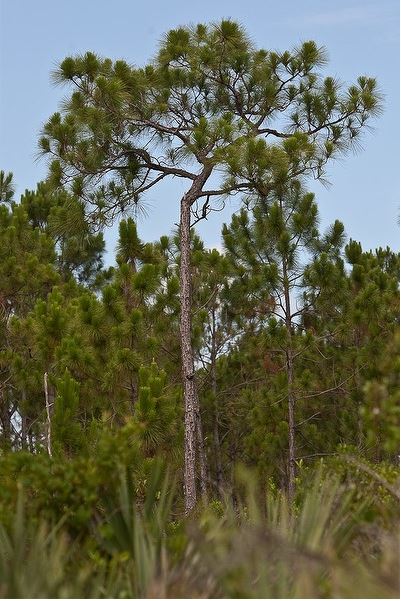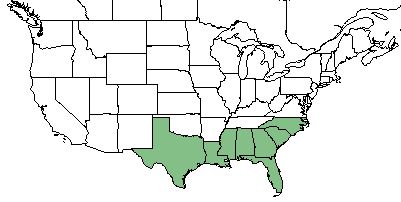Pinus elliottii
Common name: slash pine[1]
| Pinus elliottii | |
|---|---|

| |
| Photo by John B hosted at Bluemelon.com/poaceae | |
| Scientific classification | |
| Kingdom: | Plantae |
| Division: | Magnoliophyta - Flowering plants |
| Class: | Magnoliopsida - Dicots |
| Order: | Pinales |
| Family: | Pinaceae |
| Genus: | Pinus |
| Species: | P. elliottii |
| Binomial name | |
| Pinus elliottii Engelm. | |

| |
| Natural range of Pinus elliottii from USDA NRCS Plants Database. | |
Contents
Taxonomic Notes
Synonyms: Pinus elliottii var. elliottii[1]
Varieties: none[1]
Description
P. elliottii is a perennial tree of the Pinaceae family native to North America.[2] Seedlings have tall, thin trunks with open groups of needles.[3]
Distribution
P. elliottii is found along the southeastern coast of the United States from Texas to North Carolina.[2]
Ecology
Habitat
P. elliottii proliferates in wet pine flatwoods and maritime forests.[1] Specimens have been collected from sandy soils with virgin slash pine flatwoods, hollows between stable sand dunes, on bay shore of island, mixed hardwood swamp, pine plantation, open grassy field, in dry loamy sand of sandhill flat, longleaf pine community, and pine-oak-sweet gum woods.[4]
P. elliottii reduced its crown cover and biomass in response to heavy silvilcuture in north Florida pine flatwoods. It has shown resistance to regrowth in reestablished habitat that was disturbed by these practices.[5]
It increased its foliar cover in response to soil disturbance by clearcutting and roller chopping in north Florida. It has shown regrowth in reestablished native pine habitat that was disturbed by these practices.[6]
Pinus elliottii var. elliottii is frequent and abundant in the Peninsula Xeric Sandhills, North Florida Longleaf Woodlands, North Florida Subxeric Sandhills, Xeric Flatwoods, North Florida Mesic Flatwoods, Central Florida Flatwoods/Prairies, Calcareous Savannas, North Florida Wet Flatlands, and Upper Panhandle Savannas community types as described in Carr et al. (2010).[7]
Pinus elliottii var. densa is frequent and abundant in the Central Florida Flatwoods/Prairies community type as described in Carr et al. (2010).[8]
Seed dispersal
This species is thought to be dispersed by wind.[9]
Habitat
Adapted to mesic sites.[10]
Fire ecology
P. elliottii is fire resistant, but has a low fire tolerance;[2] despite this, populations have been known to persist through repeated annual burning.[11] P. elliottii var. densa has thick bark as an adult and a 'grass' stage as a juvenile that offer resistance to fire damage.[12]
Herbivory and toxicology
Pinus elliottii has been observed to host plant bugs such as Phoenicocoris australis (family Miridae).[13]
Conservation, cultivation, and restoration
Cultural use
Photo Gallery
References and notes
- ↑ 1.0 1.1 1.2 1.3 Weakley, A.S. 2020. Flora of the Southeastern United States. Edition of 20 October 2020. University of North Carolina at Chapel Hill, Chapel Hill, North Carolina.
- ↑ 2.0 2.1 2.2 USDA Plant Database https://plants.usda.gov/core/profile?symbol=PIEL
- ↑ Moyroud R. 1996 South Florida Slash Pine Pinus ellioti variety densa Palmetto 16(4):11-12
- ↑ URL: http://herbarium.bio.fsu.edu. Last accessed: June 2018. Collectors: Andre F. Clewell, E.A. Hebb, Elbert L. Little Jr., R.K. Godfrey, Cecil Slaughter, D.B. Ward, Poppleton, A.G. Shuey, Robert Kral, Patricia Elliot, Gwynn W. Ramsey, H. Larry E. Stripling, Loran Anderson, Bruce Hansen, T. Myint, R.R> Smith, F.C. Craighead, R. Komarek. States and counties: Florida (Wakulla, Hendry, Franklin, Leon, Flagler, lake, Monroe, Martin, Liberty, Madison, Gadsden, Lee, Highlands, Dade, Osceola) Georgia (Grady)
- ↑ Conde, L.F., B.F. Swindel, and J.E. Smith. (1986). Five Years of Vegetation Changes Following Conversion of Pine Flatwoods to Pinus elliottii Plantations. Forest Ecology and Management 15(4):295-300.
- ↑ Lewis, C.E., G.W. Tanner, and W.S. Terry. (1988). Plant responses to pine management and deferred-rotation grazing in north Florida. Journal of Range Management 41(6):460-465.
- ↑ Carr, S.C., K.M. Robertson, and R.K. Peet. 2010. A vegetation classification of fire-dependent pinelands of Florida. Castanea 75:153-189.
- ↑ Carr, S.C., K.M. Robertson, and R.K. Peet. 2010. A vegetation classification of fire-dependent pinelands of Florida. Castanea 75:153-189.
- ↑ Kirkman, L. Katherine. Unpublished database of seed dispersal mode of plants found in Coastal Plain longleaf pine-grasslands of the Jones Ecological Research Center, Georgia.
- ↑ Moyroud R. 1996 South Florida Slash Pine Pinus elliottii variety densa Palmetto 16(4):11-12
- ↑ Platt, W.J., R. Carter, G. Nelson, W. Baker, S. Hermann, J. Kane, L. Anderson, M. Smith, K. Robertson. 2021. Unpublished species list of Wade Tract old-growth longleaf pine savanna, Thomasville, Georgia.
- ↑ Abrahamson, W. G. and C. R. Abrahamson (1996). "Effects of Fire on Long-Unburned Florida Uplands." Journal of Vegetation Science 7(4): 565-574.
- ↑ Discoverlife.org [1]